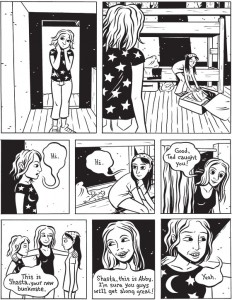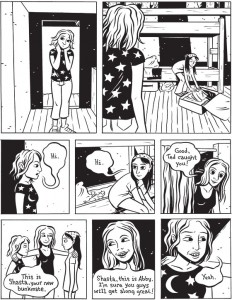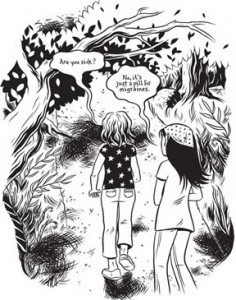Welcome to Using Graphic Novels in Education, an ongoing feature from CBLDF that is designed to allay confusion around the content of graphic novels and to help parents and teachers raise readers. In this column, we examine graphic novels, including those that have been targeted by censors, and provide teaching and discussion suggestions for the use of such books in classrooms.
Nothing says summer quite like summer camp, so in this column, we highlight Chiggersby Hope Larson (Atheneum Books, 2008), a young adult graphic novel about the friendships, fun, and foils of summer camp.
Chiggers is graphic novel that takes an honest look at the timeless ritual of summer camp as seen and experienced first-hand by Abby, a young teen attending her last year as a camper at sleep-away camp. Chiggers is a Junior Library Guild Selection and YALSA Great Graphic Novel for Teens Nominee. It follows Abby from the moment her parents rush her out of the house and drive her through country highways and hills to get her to camp before any other campers arrive and concludes when her parents are the first car in line on the last day of camp to take her home. It’s a story about friendship, fitting in, love, and loyalty, and it interweaves realities and fantasies of summer life.
Table of Contents
BRIEF OVERVIEW
Abby finds herself torn between her old and familiar summer friends and an intriguing new girl Shasta. In addition to the daily drama in her bunk, where her old friends appear to judge Shasta harshly and unfairly, there is also drama between Abby and Shasta as they find themselves attracted to the same boy. Amidst all the summer drama fun, Larson includes the Egyptian Rat Screw card game and friendship bracelets, along with how-to directions.
SUMMARY
The book opens with Abby who gets to camp way earlier than any of the other campers. The good news is she gets the pick of the bunks; the bad news is that she waits a long time for anyone else to join her. As she waits, she takes out a book to read, and her friend Rose, who is a few years older than Abby and their Cabin Assistant, briefly stops by to say hello. Slowly, the other girls arrive, and it is clear that there are cabin cliques.
Abby’s friends are Beth and Zoe. Beth’s ears are triple-pierced, and when she’s sixteen she plans to pierce her nose. Beth loves the band Spite Storm, whose poster she hangs by her bunk, and she tells Abby that she’s starting a band (“when I get better at guitar”) with her boyfriend. Zoe is also an avid Spite Storm fan who’s “totally in love with Ricky Vee.” As Zoe and Beth discuss Spite Storm’s albums, Abby feels totally “uncool” and very left out. But soon they play Egyptian Rat Screw (Larson includes the instructions), and all is good. Deni, the girl who has the bottom bunk in Abby’s bed, is homesick and part of another group of girls. She is appalled that Asheville’s such a hick town and that iPods aren’t allowed in camp — nor are watches — and she leaves camp the next day.
Replacing Deni is a new girl, Shasta, who Abby is asked to show around. Abby seems to have an instant connection with Shasta. Shasta’s from Florida, “the lightning capital of the world,” and Abby’s grandmother sometimes lives nearby. Abby’s from North Carolina “hick capital of the world.” They also share a favorite book, Outlaw Queen of Minas, which they’ve both read A LOT. As Abby shows Shasta around camp, she learns that Shasta has an Internet boyfriend, is one-eighth Cherokee, and was struck by lightning.
Abby’s life in camp isn’t easy. One problem is that Beth and Zoe don’t like Shasta, and they let Abby know this as often as they can. Abby has to figure out how to maintain her friendship with Shasta without wrecking her friendship with Beth and Zoe. Another problem is that Shasta always seems to have an excuse for not joining in camp activities. This makes Abby wonder about her choice in friends. One final problem between Abby and Shasta is that they both like Teal, a nerdy Dungeon Master who is Rose’s cousin. As the summer progresses, Shasta breaks up with her Internet boyfriend and feels she, like Abby, has a “special connection” with Teal. Finally, as things can’t seem to get any worse, Shasta is almost struck a second time by lightning (Abby saves her), but she is sent away from camp early because she hasn’t taken her medication and the camp feels they can no longer be responsible for Shasta. Shasta and Abby resolve their differences and part as friends.
Hope Larson tells a strong story about friendship, loyalty, and choices and provides card game and friendship bracelet instructions, making this a heart-warming summer choice for young teenagers.
The rest of the story is up to you to read and enjoy.
In short, Chiggers is about friendship, camp cliques, and games, and learning from both good and bad choices. It is recommended for young teens and older. In addition to Larson’s nuanced characters and summer exploits Chiggers is about:
- Navigating friendships in and out of cliques;
- Taking ownership for decisions and learning from them;
- Dealing with the need to belong while maintaining individuality and independence;
- An honest look at the ins and outs of summer sleep-away camp.
TEACHING/DISCUSSION SUGGESTIONS
Cultural Diversity, Civic Responsibilities, and Social Issues
- Hope Larson is a master at developing her characters. Discuss how Larson establishes the cabin cliques and how expectations are set based on stereotypes. Discuss how well these stereotypes hold throughout the book.
- Have students work individually, in pairs, or in groups to create a Venn diagram representing how Abby, Beth, Zoe, and Shasta’s personalities, likes, and dislikes overlap. Have students discuss the similarities and differences among these friends.
- Discuss how important it is to Abby to fit in with Beth and Zoe. Find incidents where Abby does and does not fit in with them. Discuss what strategies your students might use in those same situations.
Language, Literature, and Language Usage
- Discuss Larson’s choice of titles for the band name (Spite Storm) and their song/album titles (Chrome Unicorn, On Jupiter). What type of music might they play, and what might the content of those songs be? What about the band Beth wants to start with her boyfriend (Glittergloom)? Have students discuss band and song titles they might create and why.
- On page 9, Deni says, “Did you see Asheville from the plane? Total hick town.” Her friend adds, “My aunt lives there, and she’s scared to walk downtown ‘cause of all the hippies.” What is this friend implying? Discuss why her aunt would be afraid of the hippies.
- Discuss Larson’s choice of title and how chiggers relate to the story (see links below for more on chiggers).
Critical Thinking and Inferences
The author makes many inferences in this book both with language use and through imagery. You may want to discuss the following uses of inference:
- This book is all about navigating social situations at summer camp. Have students come up with their own handbooks or unofficial social rules for camp and for school. Discuss how, if at all, they might differ.
- When meeting Shasta for the first time at lunch, Beth asks, “So are you the new Deni?” What does she mean by this?
- On page 49, after meeting Shasta, Beth passes Abby a note about Shasta saying, “I HATE HER!! What’s her problem? She’s really snobby!” Why would they get that impression?
Modes of Storytelling and Visual Literacy
In graphic novels, images are used to relay messages with and without accompanying text, adding additional dimension to the story. Compare, contrast, and discuss with students how images can be used to relay complex messages. For example:
- Working individually, in pairs, or in groups, have students chart how Larson moves from fantasy panels (daydreaming, sleeping, thinking about crushes, etc.) to real life panels. Discuss Larson’s use of text and images towards this end.
- Evaluate and discuss how Larson creates a sense of magic around Shasta’s experience around will-o-wisps and lightening (see pages 54-55 for examples).
- On page 70, Abby was split from Beth and Zoe at lunch (there weren’t three seats together). Beth and Zoe sat together and Shasta had saved a seat for Abby with some guys from her Wilderness group. At one point, Abby walks away and sees Beth and Zoe talking. There are two panels across the page, one with empty odd shaped text balloons and the next with snakes and thorny vines slinking out of their mouths. What message do these images relay?
Suggested Prose and Graphic Novel Pairings
For greater discussion on literary style and/or content, here are some prose novels and graphic novels you may want to read with Chiggers
- Nothing Can Possibly Go Wrong by Prudence Shen and Faith Erin Hicks — a graphic novel full of unlikely friendships and nicely nuanced characters who bend and shatter stereotypes and expectations.
- Stuck in the Middle: Seventeen Comics from an UNPLEASANT Age — an anthology of honest, sensitive and humorous comics about the early teen years edited by Ariel Schrag. In this anthology, seventeen comic book artists relate incidents from their “awkward” middle school years.
- Smile by Raina Telgemeier — a graphic novel memoir about Raina’s awkward middle school years compounded with added embarrassment of serious dental issues.
- The Absolutely True Story of a Part Time Indian by Sherman Alexie — about a bright motivated young Native American who must decide between a long commute to a better all-white school off the reservation and face ridicule from white kids he must befriend and from his local friends he leaves behind, or to remain with his friends at the reservation’s limited high school and head nowhere fast.
- Diary of a Wimpy Kid by Jeff Kinney — a series about a boy and his struggles in middle school.
- Stargirl by Jerry Spinelli — about the impact of peer pressure and bullying on the new and different girl (Stargirl) and on Leo, the narrator, who wrestles with the peer pressure surrounding him.
COMMON CORE STATE STANDARDS (CCSS)
While Chiggers is recommended for ages 10-14, it is appropriate for students in grades 5 and up. As it can be effectively used with mature middle and high school students, I will be relating how they can be used in classrooms meeting the Common Core State Standards. Reading Chiggers and incorporating the teaching suggestions above promotes critical thinking and its graphic novel format provides verbal and visual story telling that addresses multi-modal teaching. Here’s a more detailed look:
- Knowledge of Language: Apply knowledge of language to understand how language functions in different contexts, to make effective choices for meaning or style, to comprehend more fully when reading or listening.
- Vocabulary Acquisition and Use: Determine or clarify the meaning of unknown and multiple-meaning words and phrases by using context clues, analyzing meaningful word parts, and consulting general and specialized reference materials; demonstrate understanding of figurative language, word relationships, and nuances in word meaning; acquire and use accurately a range of general academic and domain-specific words and phrases sufficient for reading, writing, speaking and listening at the college and career readiness level.
- Key ideas and details: Reading closely to determine what the texts says explicitly and making logical inferences from it; citing specific textual evidence when writing or speaking to support conclusions drawn from the text; determining central ideas or themes and analyzing their development; summarizing the key supporting details and ideas; analyzing how and why individuals, events, or ideas develop and interact over the course of the text.
- Craft and structure: Interpreting words and phrases as they are used in a text, including determining technical, connotative, and figurative meanings and analyzing how specific word choices shape meaning or tone; analyzing the structure of texts, including how specific sentences, paragraphs and larger portions of the text relate to each other and the whole; Assessing how point of view or purpose shapes the content and style of a text.
- Integration of knowledge and ideas: Integrate and evaluate content presented in diverse media and formats, including visually…as well as in words; delineate and evaluate the argument and specific claims in a text, including the validity of the reasoning as well as the relevance and sufficiency of the evidence; analyze how two or more texts address similar themes or topics in order to build knowledge or to compare the approaches the authors take
- Range of reading and level of text complexity: Read and comprehend complex literary and informational texts independently and proficiently
- Comprehension and collaboration: Prepare for and participate effectively in a range of conversations and collaborations with diverse partners, building on others’ ideas and expressing their own clearly and persuasively; integrate and evaluate information presented in diverse media and formats, including visually, quantitatively and orally; evaluate a speaker’s point of view, reasoning, and use of evidence and rhetoric.
ADDITIONAL RESOURCES
- http://animals.howstuffworks.com/arachnids/question488.htm: for details about chiggers and their bites.
- http://www.hopelarson.com/portfolio-item/chiggers/: for a preview of the book
Meryl Jaffe, PhD teaches visual literacy and critical reading at Johns Hopkins University Center for Talented Youth Online Division and is the author of Raising a Reader! and Using Content-Area Graphic Texts for Learning. She used to encourage the “classics” to the exclusion comics, but with her kids’ intervention, Meryl has become an avid graphic novel fan. She now incorporates them in her work, believing that the educational process must reflect the imagination and intellectual flexibility it hopes to nurture. In this monthly feature, Meryl and CBLDF hope to empower educators and encourage an ongoing dialogue promoting kids’ right to read while utilizing the rich educational opportunities graphic novels have to offer. Please continue the dialogue with your own comments, teaching, reading, or discussion ideas at meryl.jaffe@cbldf.org and please visit Dr. Jaffe at http://www.departingthe text.blogspot.com.
We need your help to keep fighting for the right to read! Help support CBLDF’s important First Amendment work by visiting the Rewards Zone, making a donation, or becoming a member of CBLDF!
All images (c) Hope Larson.







